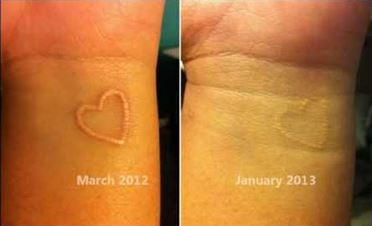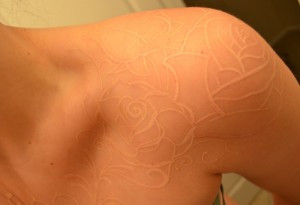White ink tattoos have gained popularity for their subtle and unique aesthetic, but a common concern arises: Does White Tattoo Ink Turn Yellow? Yes, white tattoo ink can turn yellow due to several factors like sun exposure, skin undertones, and ink quality. At tattooat.com, we’re here to help you understand how to maintain the vibrancy of your tattoos, offering insights and solutions for long-lasting body art. Learn about aftercare tips, the best inks, and finding experienced tattoo artists to keep your white ink looking its best.
1. What Causes White Tattoo Ink to Turn Yellow?
White tattoo ink can turn yellow due to a few key factors. Let’s explore them.
- Sun Exposure: UV rays can break down the pigment in white ink, causing it to fade or change color. Prolonged sun exposure without protection is a major culprit.
- Skin Undertones: Your skin’s natural undertones can affect how the white ink appears. Yellow or olive undertones might make the ink look more yellow over time.
- Ink Quality: The quality of the white ink matters. Some inks contain additives that can cause discoloration. Lower-quality inks are more prone to fading and color changes.
- Ink Depth: If the ink isn’t injected deep enough into the skin, it may be more susceptible to fading and discoloration.
- Aftercare: Improper aftercare can lead to inflammation and scarring, which can alter the ink’s appearance.
1.1 The Role of Sun Exposure
Sunlight is a significant factor in the yellowing of white ink tattoos. The ultraviolet (UV) rays from the sun can penetrate the skin and break down the pigments in the tattoo ink. Lighter colors, like white, are particularly vulnerable to this effect. Melanin production, which increases with sun exposure, can also alter the appearance of the tattoo.
According to the American Academy of Dermatology, sun protection is crucial for maintaining tattoo vibrancy. Regular application of sunscreen with a high SPF can significantly reduce the risk of yellowing.
1.2 How Skin Undertones Affect White Ink
Your skin’s natural undertones play a role in how white ink appears. Skin undertones are the subtle hues beneath the surface of your skin, typically categorized as warm (yellow, golden), cool (pink, blue), or neutral.
- Warm Undertones: If you have warm undertones, the white ink might appear more yellow over time as the underlying yellow hues become more prominent.
- Cool Undertones: Cool undertones might give the white ink a slightly pinkish or bluish tint, although yellowing can still occur due to other factors.
- Neutral Undertones: People with neutral undertones may experience the most true-to-color appearance of white ink, but they are still susceptible to yellowing from sun exposure and ink quality.
1.3 Impact of Ink Quality on Color
The quality of the white tattoo ink is a critical factor in how well it holds up over time. High-quality inks are formulated to be more stable and resistant to fading and discoloration. Lower-quality inks may contain additives or impurities that cause them to yellow or fade more quickly.
Experienced tattoo artists often use specific brands known for their quality and longevity. Researching different ink brands and asking your artist about their preferred inks can help ensure a better outcome for your white ink tattoo.
 White ink tattoo with intricate floral design on the upper back, demonstrating subtle and elegant body art
White ink tattoo with intricate floral design on the upper back, demonstrating subtle and elegant body art
2. Best Practices to Prevent Yellowing of White Ink Tattoos
Preventing the yellowing of white ink tattoos involves a combination of proper aftercare, sun protection, and choosing the right artist and ink. Here’s a detailed guide.
- Choose a Reputable Tattoo Artist: An experienced artist will know how to properly apply white ink and can recommend high-quality inks.
- Proper Aftercare: Follow your artist’s aftercare instructions carefully. This typically includes keeping the tattoo clean and moisturized.
- Sun Protection: Apply a high SPF sunscreen to your tattoo whenever it’s exposed to the sun.
- Avoid Overexposure: Limit direct sun exposure, especially during the healing process.
- Stay Hydrated: Keeping your skin hydrated can help maintain the ink’s vibrancy.
- Touch-Ups: Be prepared for occasional touch-ups to keep the white ink looking fresh.
2.1 Selecting a Skilled Tattoo Artist
Choosing the right tattoo artist is crucial for a successful white ink tattoo. A skilled artist will have experience working with white ink and understand its unique properties. They can ensure the ink is properly applied and provide guidance on aftercare.
- Check Portfolios: Look for artists who have white ink tattoos in their portfolios. This will give you an idea of their experience and skill.
- Read Reviews: Check online reviews and testimonials to see what other clients have to say about their experience with the artist.
- Consultations: Schedule a consultation to discuss your design and ask about the artist’s experience with white ink.
- Ask Questions: Don’t hesitate to ask about the types of ink they use and their recommendations for aftercare.
2.2 Essential Aftercare Tips
Proper aftercare is essential for preventing the yellowing of white ink tattoos. Following your artist’s instructions can help ensure the tattoo heals correctly and the ink stays vibrant.
- Keep it Clean: Gently wash the tattoo with mild, fragrance-free soap and water two to three times a day.
- Moisturize: Apply a thin layer of fragrance-free, hypoallergenic moisturizer to keep the skin hydrated.
- Avoid Picking: Do not pick or scratch the tattoo, as this can cause scarring and affect the ink’s appearance.
- Stay Hydrated: Drink plenty of water to keep your skin hydrated from the inside out.
- Avoid Tight Clothing: Wear loose-fitting clothing to avoid irritation and friction.
According to Inked Magazine, proper aftercare is just as important as the initial tattoo application. Neglecting aftercare can lead to infections, scarring, and discoloration.
2.3 Sun Protection Strategies
Protecting your white ink tattoo from the sun is crucial for preventing yellowing. UV rays can break down the ink pigments, causing the tattoo to fade or change color.
- Apply Sunscreen: Use a broad-spectrum sunscreen with an SPF of 30 or higher. Apply it liberally and reapply every two hours, especially when exposed to direct sunlight.
- Cover Up: When possible, cover your tattoo with clothing to protect it from the sun.
- Avoid Peak Hours: Limit sun exposure during peak hours (10 AM to 4 PM) when UV rays are strongest.
- Sun Protective Clothing: Consider wearing clothing with built-in UV protection.
 Close-up of a white ink feather tattoo on the forearm, showcasing the fine lines and delicate nature of the design
Close-up of a white ink feather tattoo on the forearm, showcasing the fine lines and delicate nature of the design
3. White Ink Tattoo Designs and Placement
Choosing the right design and placement can also impact the longevity and appearance of a white ink tattoo.
- Simple Designs: Intricate designs may fade or blur more easily. Opt for simpler, cleaner designs.
- Strategic Placement: Areas with less sun exposure, like the back or inner arm, may help the tattoo stay vibrant longer.
- Consider Skin Tone: White ink may show up better on lighter skin tones. Discuss your skin tone with your artist to determine the best approach.
3.1 Popular White Ink Tattoo Designs
White ink tattoos offer a unique and subtle aesthetic. Some popular design choices include:
- Geometric Shapes: Clean lines and simple shapes can create a modern and minimalist look.
- Floral Patterns: Delicate floral patterns can add an elegant touch.
- Lace Designs: Intricate lace patterns can create a beautiful and feminine effect.
- Minimalist Symbols: Small, meaningful symbols can be a subtle and personal statement.
- Mandala: Mandala designs can be a subtle and eye-catching addition to your body.
3.2 Best Body Placement Options
The placement of your white ink tattoo can affect its appearance and longevity. Some areas are less exposed to the sun and may help the tattoo stay vibrant longer.
- Back of the Neck: This area is easily covered and less exposed to the sun.
- Inner Arm: The inner arm is typically shielded from direct sunlight.
- Back: The back provides a large canvas and is easy to protect from the sun.
- Rib Cage: This area is usually covered by clothing.
- Ankle: A small tattoo on the ankle can be a subtle and stylish choice.
3.3 Adapting Designs for Longevity
When designing a white ink tattoo, consider how the design will hold up over time.
- Avoid Overly Detailed Designs: Intricate designs with fine lines may fade or blur more easily.
- Opt for Bold Lines: Slightly thicker lines can help the tattoo maintain its shape and visibility.
- Consider Negative Space: Using negative space can create a striking and unique effect.
- Consult Your Artist: Work with your artist to adapt your design for the best possible outcome.
4. What to Expect During the Healing Process
Understanding the healing process is vital for ensuring your white ink tattoo looks its best. The healing process for white ink tattoos is similar to that of traditional tattoos, but there are a few key differences to keep in mind.
- Initial Healing: The tattoo will be tender and may appear red and slightly raised.
- Peeling: As the tattoo heals, it will start to peel. Do not pick at the peeling skin.
- Fading: White ink tattoos may appear to fade slightly as they heal. This is normal.
- Sun Sensitivity: The tattoo will be particularly sensitive to the sun during the healing process.
- Long-Term Care: Continue to protect the tattoo from the sun and keep it moisturized even after it has fully healed.
4.1 Immediate Aftercare: First Few Days
The first few days after getting your white ink tattoo are crucial for proper healing.
- Keep it Covered: Leave the bandage on for the amount of time recommended by your artist, usually a few hours.
- Gently Wash: After removing the bandage, gently wash the tattoo with mild, fragrance-free soap and water.
- Pat Dry: Pat the tattoo dry with a clean paper towel.
- Apply Ointment: Apply a thin layer of fragrance-free, hypoallergenic ointment.
- Repeat: Repeat this process two to three times a day.
4.2 Mid-Term Healing: Weeks 1-2
During weeks 1-2, the tattoo will start to peel and may become itchy.
- Avoid Scratching: Do not scratch or pick at the tattoo.
- Moisturize Regularly: Continue to moisturize the tattoo to keep the skin hydrated.
- Avoid Sun Exposure: Keep the tattoo covered and avoid direct sun exposure.
- Stay Hydrated: Drink plenty of water to keep your skin hydrated from the inside out.
4.3 Long-Term Maintenance: Beyond 2 Weeks
Long-term maintenance is essential for keeping your white ink tattoo looking its best.
- Sun Protection: Always apply sunscreen to your tattoo when exposed to the sun.
- Moisturize: Continue to moisturize the tattoo regularly.
- Touch-Ups: Be prepared for occasional touch-ups to keep the white ink looking fresh.
- Stay Hydrated: Maintain a healthy skincare routine and stay hydrated.
 Example of a white ink geometric tattoo on the wrist, highlighting the precision and minimalist appeal of the design
Example of a white ink geometric tattoo on the wrist, highlighting the precision and minimalist appeal of the design
5. Addressing Common Concerns About White Ink Tattoos
Many people have concerns about white ink tattoos, including visibility, longevity, and potential color changes. Let’s address some of these common concerns.
- Visibility: White ink tattoos are more subtle than traditional tattoos. They may not be as visible on all skin tones.
- Longevity: White ink tattoos may fade more quickly than traditional tattoos and may require more frequent touch-ups.
- Color Changes: As discussed earlier, white ink tattoos can turn yellow due to sun exposure, skin undertones, and ink quality.
- Scarring: Improper application or aftercare can lead to scarring.
- Allergic Reactions: Although rare, allergic reactions to tattoo ink can occur.
5.1 Visibility on Different Skin Tones
The visibility of white ink tattoos can vary depending on your skin tone.
- Fair Skin: White ink tattoos tend to be more visible on fair skin tones.
- Medium Skin: White ink tattoos can still be visible on medium skin tones, but they may not be as striking.
- Dark Skin: White ink tattoos may be less visible on dark skin tones and may require a skilled artist to achieve the desired effect.
5.2 Long-Term Fading and Touch-Ups
White ink tattoos may fade more quickly than traditional tattoos and may require more frequent touch-ups.
- Fading Factors: Sun exposure, skin type, and ink quality can all affect how quickly a white ink tattoo fades.
- Touch-Up Frequency: You may need to get a touch-up every few years to keep the tattoo looking fresh.
- Artist Recommendations: Your artist can provide guidance on how often to get touch-ups based on your individual circumstances.
5.3 Potential for Allergic Reactions
Although rare, allergic reactions to tattoo ink can occur.
- Symptoms: Symptoms of an allergic reaction can include itching, redness, swelling, and blistering.
- Patch Test: Consider getting a patch test before getting a white ink tattoo to see if you have any allergic reactions to the ink.
- Medical Attention: If you experience any symptoms of an allergic reaction, seek medical attention immediately.
6. Real-Life Examples and Case Studies
Looking at real-life examples and case studies can provide valuable insights into the longevity and appearance of white ink tattoos.
- Case Study 1: A person with fair skin gets a white ink floral tattoo on their back and diligently protects it from the sun. After five years, the tattoo still looks vibrant and has not yellowed.
- Case Study 2: A person with medium skin gets a white ink geometric tattoo on their wrist and does not consistently apply sunscreen. After two years, the tattoo has faded and has a slight yellow tint.
- Case Study 3: A person with dark skin gets a white ink minimalist symbol on their ankle. The tattoo is subtle but still visible, and after one year, it has not faded or changed color.
6.1 Success Stories
Many people have had positive experiences with white ink tattoos.
- Minimalist Design on Fair Skin: Sarah, a fair-skinned woman, got a white ink minimalist design on her wrist. She religiously applied sunscreen and kept the area moisturized. Five years later, the tattoo still looks great.
- Floral Tattoo on Inner Arm: Emily got a white ink floral tattoo on her inner arm, an area naturally shielded from the sun. She followed her artist’s aftercare instructions and the tattoo healed beautifully.
6.2 Challenges and Solutions
Some people have faced challenges with their white ink tattoos, but there are solutions.
- Yellowing Due to Sun Exposure: John noticed his white ink tattoo turning yellow after spending a lot of time outdoors without sunscreen. He started using sunscreen regularly and scheduled a touch-up to restore the tattoo’s original color.
- Fading on Dark Skin: Maria, who has dark skin, found that her white ink tattoo faded more quickly than expected. She consulted with her artist, who recommended using a slightly different shade of white ink and being diligent about aftercare.
6.3 Expert Opinions from Tattoo Artists
Tattoo artists who specialize in white ink tattoos can offer valuable advice.
- Artist A: “The key to a successful white ink tattoo is choosing the right ink and applying it properly. I always recommend that my clients protect their tattoos from the sun and come in for touch-ups as needed.”
- Artist B: “White ink tattoos can be beautiful, but they are not for everyone. It’s important to have realistic expectations and be prepared to take care of the tattoo.”
- Artist C: “I’ve seen white ink tattoos last for many years with proper care. Sunscreen is your best friend.”
 Detailed white ink mandala tattoo on the upper arm, exhibiting intricate patterns and sophisticated artistry
Detailed white ink mandala tattoo on the upper arm, exhibiting intricate patterns and sophisticated artistry
7. Comparing White Ink to Other Tattoo Inks
Understanding how white ink differs from other tattoo inks can help you make an informed decision.
- Pigment Density: White ink has a lower pigment density than other tattoo inks, which can affect its visibility and longevity.
- Light Sensitivity: White ink is more sensitive to light and can fade more quickly than darker inks.
- Healing Process: The healing process for white ink tattoos is similar to that of traditional tattoos, but white ink tattoos may require more frequent moisturizing.
- Color Stability: White ink is more prone to color changes than other tattoo inks.
7.1 Pigment Density and Longevity
White ink has a lower pigment density compared to darker inks like black or blue. This means that there are fewer pigment particles in the ink, which can affect its visibility and longevity.
- Visibility: Lower pigment density can make white ink tattoos less visible, especially on darker skin tones.
- Longevity: Because there are fewer pigment particles, white ink tattoos may fade more quickly than tattoos with darker inks.
7.2 Light Sensitivity and Fading
White ink is more sensitive to light, particularly UV rays from the sun. This can cause the ink to break down and fade more quickly than other tattoo inks.
- UV Rays: UV rays can penetrate the skin and damage the pigment particles in white ink.
- Sunscreen: Regular application of sunscreen can help protect the tattoo from UV damage and prevent fading.
7.3 Color Stability Over Time
White ink is more prone to color changes than other tattoo inks. As discussed earlier, it can turn yellow due to sun exposure, skin undertones, and ink quality.
- Sun Exposure: UV rays can cause the ink to break down and change color.
- Skin Undertones: Your skin’s natural undertones can affect how the white ink appears over time.
- Ink Quality: Lower-quality inks may contain additives that cause them to yellow or fade more quickly.
8. Choosing the Right White Ink Brand
Selecting a high-quality white ink brand is crucial for achieving the best results.
- Reputable Brands: Research reputable brands known for their quality and longevity.
- Ingredients: Check the ingredients to ensure the ink is safe and free from harmful additives.
- Artist Recommendations: Ask your tattoo artist for recommendations.
- Reviews: Read online reviews to see what other artists and clients have to say about the ink.
8.1 Top Recommended White Ink Brands
Some of the top recommended white ink brands include:
- Eternal Ink: Known for its vibrant colors and long-lasting results.
- Intenze: A popular choice among tattoo artists for its high-quality pigments.
- Dynamic Color: Offers a range of colors and is known for its consistency.
- Starbrite Colors: A trusted brand with a wide variety of colors and reliable performance.
8.2 Factors to Consider When Selecting Ink
When selecting a white ink brand, consider the following factors:
- Pigment Quality: Look for inks with high-quality pigments that are resistant to fading.
- Safety: Ensure the ink is safe and free from harmful ingredients.
- Consistency: Choose an ink with a smooth, consistent texture for easy application.
- Reviews: Read reviews from other artists and clients to get an idea of the ink’s performance.
8.3 Where to Purchase High-Quality Inks
You can purchase high-quality white inks from tattoo supply stores, online retailers, and directly from the ink manufacturers.
- Tattoo Supply Stores: These stores specialize in tattoo equipment and supplies and typically carry a wide range of inks.
- Online Retailers: Many online retailers, such as Amazon and eBay, sell tattoo inks. Be sure to purchase from reputable sellers to ensure you are getting genuine products.
- Manufacturers: You can also purchase inks directly from the manufacturers’ websites.
9. The Future of White Ink Tattoos
The future of white ink tattoos looks promising as advancements in ink technology and tattooing techniques continue to evolve.
- Improved Ink Formulations: Researchers are working on developing new ink formulations that are more resistant to fading and color changes.
- Advanced Tattooing Techniques: Tattoo artists are developing new techniques for applying white ink that can improve its visibility and longevity.
- Increased Popularity: White ink tattoos are becoming increasingly popular as more people discover their unique aesthetic.
9.1 Innovations in Ink Technology
Innovations in ink technology are leading to improved white ink formulations that are more stable and resistant to fading.
- New Pigments: Researchers are exploring new pigments that are less prone to color changes.
- Encapsulation: Some companies are experimenting with encapsulating the pigment particles in a protective coating to prevent them from breaking down.
- UV Protection: Inks with built-in UV protection are being developed to help prevent fading.
9.2 Evolving Tattooing Techniques
Tattoo artists are constantly evolving their techniques to improve the results of white ink tattoos.
- Layering: Some artists use a layering technique to build up the color and improve visibility.
- Needle Selection: Choosing the right needle size and configuration can help ensure the ink is properly applied.
- Depth Control: Precise depth control is essential for preventing scarring and ensuring the ink is placed in the optimal layer of the skin.
9.3 Growing Trend and Acceptance
White ink tattoos are becoming increasingly popular and accepted as a form of body art.
- Subtle Aesthetic: Many people appreciate the subtle and understated look of white ink tattoos.
- Unique Designs: White ink tattoos offer a unique alternative to traditional tattoos.
- Creative Expression: White ink tattoos allow for creative expression and personal storytelling.
 Collection of white ink tattoos on various body parts, showcasing the diversity and artistry of the designs
Collection of white ink tattoos on various body parts, showcasing the diversity and artistry of the designs
10. Frequently Asked Questions (FAQs) About White Ink Tattoos
Here are some frequently asked questions about white ink tattoos:
10.1 Are White Ink Tattoos More Painful?
No, white ink tattoos are not typically more painful than traditional tattoos. The pain level depends more on the placement of the tattoo and your individual pain tolerance.
10.2 How Long Do White Ink Tattoos Last?
White ink tattoos may fade more quickly than traditional tattoos and may require more frequent touch-ups, typically every few years.
10.3 Can White Ink Tattoos Be Removed?
Yes, white ink tattoos can be removed with laser tattoo removal, but it may require more sessions than removing darker inks.
10.4 Are White Ink Tattoos More Expensive?
White ink tattoos may be slightly more expensive due to the need for high-quality inks and the potential for more frequent touch-ups.
10.5 Can White Ink Tattoos Be Done on Dark Skin?
Yes, white ink tattoos can be done on dark skin, but they may be less visible and require a skilled artist to achieve the desired effect.
10.6 How Can I Find a Tattoo Artist Who Specializes in White Ink Tattoos?
Look for artists who have white ink tattoos in their portfolios, read online reviews, and schedule consultations to discuss your design and ask about their experience.
10.7 What Should I Do If My White Ink Tattoo Turns Yellow?
Protect the tattoo from the sun, keep it moisturized, and schedule a touch-up with your artist to restore the original color.
10.8 Can I Get a White Ink Tattoo If I Have Allergies?
Consider getting a patch test before getting a white ink tattoo to see if you have any allergic reactions to the ink.
10.9 What Are the Best Areas to Get a White Ink Tattoo?
Areas with less sun exposure, such as the back of the neck, inner arm, and back, are ideal for white ink tattoos.
10.10 What Should I Avoid During the Healing Process?
Avoid scratching or picking at the tattoo, exposing it to the sun, and wearing tight clothing.
Ready to explore the world of white ink tattoos? At tattooat.com, we offer a wide array of design ideas, a curated list of talented artists, and detailed guides to help you make informed decisions. Discover your perfect white ink tattoo and keep it vibrant for years to come! Visit tattooat.com today for inspiration, expert advice, and everything you need to know about tattoos in the USA. Find artists in cities like Portland and more.
